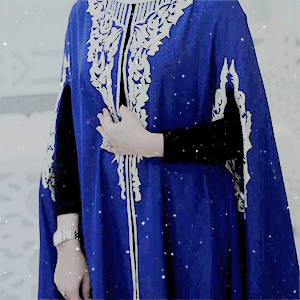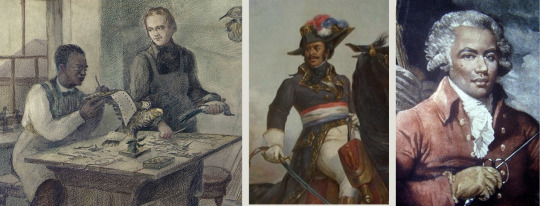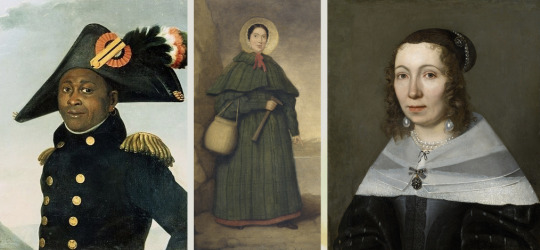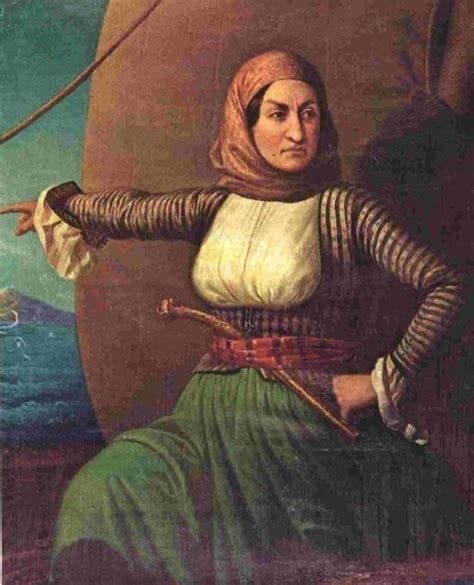#sayyida al-hurra
Text
It's so funny to me when certain people think they're doing something so revolutionary by having female pirates. Like they invented the concept.
My guy, women were pirates. Zheng Yi Sao was one of the most successful pirates (or the most successful? can't remember) and she was a woman. Anne Bonny, Mary Read, Gráinne Ní Mháille, Sayyida al-Hurra, all women.
Going on and on about the gender of the pirates is annoying. You should actually flesh them out. Your female characters are still people and if all they can do is bring up their gender, it gets old after a while.
#i really like pirates and its really annoying when people try to be feminist by just... ignoring what women have done#female pirates arent some thing that modern authors invented. female pirates existed#zheng yi sao#anne bonny#mary read#grainne ni mhaille#sayyida al-hurra#rachel wall#female characters#strong female characters#female pirates#pirates#the golden age of piracy#women's history#all queued up with nowhere to go
118 notes
·
View notes
Text









badass women of history ↝ sayyida al hurra, the pirate queen of morocco
sayyida al hurra, real name lalla aicha bint ali ibn rashid al-alami, was hakimat titwan between 1515–1542 and a moroccan privateer leader during the early 16th century. she became the wife of the wattasid sultan ahmad ibn muhammad.
#sayyida al hurra#historyedit#historicaledit#history edit#historical edit#badass women of history#bwoh#morocco#moroccan history#women in history#historyedit*#moodboard#moodboard*#mine
97 notes
·
View notes
Text
i just wanna share this.
i want a period piece show about female pirates. like, that tells the stories of them. not just Anne Bonney, Mary Read, & Ching Shih. i want them and also Joanna of Flanders, Duchess of Brittany (c. 1295 – September 1374) & Jeanne de Clisson, the Lioness of Brittany (1300 – 1359). i want Gráinne O'Malley/Grace O'Malley/Gráinne Ní Mháille (c. 1530 – c. 1603), Sayyida al Hurra (1485 – July 14th, 1561), and the women of the Killigrew family. i want the possibly fictional, possibly real pirate women of Charlotte de Berry (17th century) & Jacquotte Delahaye (fl. 1656). i want the real but stories are mostly probably fictional Anne Dieu-le-Veut (August 28th, 1661 – January 11th, 1710). i want something that shows us the pirate women from outside Europe & the Caribbean, i want the Canadian pirate woman, Maria Lindsey, and the American pirate woman, Rachel Wall.
#pirates#female pirates#pirate women#13th century#14th century#16th century#15th century#17th century#anne bonny#mary read#ching shih#zheng yi sao#joanna of flanders#jeanne de clisson#the lioness of brittany#grace o'malley#grainne o'mally#sayyida al hurra#killigrew#killigrew family#charlotte de berry#jacquotte delahaye#anne dieu-le-veut#maria lindsey#rachel wall
7 notes
·
View notes
Link
“The 16th century was a volatile and violent era in which cities such as Tétouan required decisive, strong, competent, and intelligent leaders to survive. Al-Sayyida al-Hurra was definitely all these things and more. She was a woman who rose to power and ruled in her own right for decades. She did not hesitate to take action, when necessary, in the form of diplomacy and outright war to safeguard her city. Despite the scarce information on her life in the sources, she certainly left her mark on history.”
#Al-Sayyida al-Hurra#history#women in history#women's history#queens#pirates#pirate women#morocco#moroccan history#16th century
6 notes
·
View notes
Text
Step 1. Create a character.
Step 2. Learn that someone almost exactly like her, despite all odds, has actually existed in real life.
Step 3. Be absolutely baffled.
#i'm STUNNED#history of piracy is awesome#sayyida al hurra#writing#reaserch#writer's journal#frozen fanfic#fanfic writing#fanfic writers
1 note
·
View note
Link
Chapter 5 is up and if you like Pirates (especially badass female ones!) then this one is for you!
#setsuna meioh#sailor pluto#tales of taskforce sol#sailor moon fanfiction#history#pirates#yang zeng yishao#ching shih#queen teuta#sayyida al hurra
1 note
·
View note
Text
In no particular order, some of the real people whose lives inspired Trice Forgotten




[ID: 12 portraits of people, either photographs of paintings. They are, in order: Ali Wallace; José Rizal; Raden Saleh; Gramman Kwasi; Mary Seacole; Sayyida al Hurra; John Edmonstone and Charles Darwin; Thomas-Alexandre Dumas; Chevalier de Saint-Georges; Toussaint Louverture; Mary Anning; Maria Merian. End ID]
130 notes
·
View notes
Note
5, 6, 16, what a lovely concept!
This was nice, thank you for asking. And also sorry because it got long.
5. something you see in fics a lot and love
There's a tendency of mentioning braids in ironborn-focused fics when describing characters like Asha or Victarion and I think it's probably motivated by "Viking"-like hairstyles depicted in pop culture but I associate it to the Dothraki so it's a sort of accidental parallel that I appreciate a lot. Also Theon getting his hair washed and cut after escaping Winterfell. I don't care who does it, immediate catharsis.
6. something you see in art a lot and love
As of late I've finally gotten to see more non-west/centre European inspiration in art and it fills my heart with glee.
More specific examples
Every time I get to see Arab, Indigenous, African or Asian inspired Iron Islands inhabitants. Admittedly, I don't think I have much of a preference because due to the thraldom and the trading with non-westerosi cultures allows for a lot of diversity but yess these are all faves. Some reasons: Arab (Stories like that of Sayyida al-Hurra, their nautical vehicles being more similar to dhows than actual viking galleys), Indigenous and African (Theon being taken away from his culture and raised by foreigners who look down on him and behave paternalistic at best mirroring the story of Leftraru and hundreds of other indigenous heroes, them choosing their kings and having a less monarchic policy than the rest of Westeros, described as dark and often facing some sort of bias, history and lore being traditionally passed orally), Asian (not gonna lie purely because the connections between Yi Ti and the Iron Islands that kind of goes overlooked by most)
Yakut or Inuit based Starks and The North ( Yakut fashion my beloved, unipkaaqs my adored)
Mesoamerican inspired Tyrells and habitants of the Reach (Remember that thing I told you about Oldtown being in Guatemala?)
Black Westerlings(/Spicers), (purely because the Spicers are descents of Maggy the Frog, who is Essosi, and a dear friend of mine is obsessed with Jeyne W in the way I'm obsessed with Jeyne P and she is mozambican)
I feel like lately a lot of these have become more accepted in fandom so there's a lot more art featuring them and I gush about that a lot.
16. a tiny detail in canon that you want more people to appreciate
I think Theon's cultural isolation during his time in Winterfell. At this point most people seem to agree that plays a role in his arc but I still feel like it's dismissed in favour of loyalty conflicts (Stark vs Greyjoy; Robb vs Balon)
An example of that could maybe be his religion. The faith of the drowned god is passed down orally, they worship no items and have no specific place of praying. The few religions in real life that still do this are often motivated by wanting to create a sense of community in their faith. There is a need to gather around together, wherever you are, in order to learn of your faith. Theon can't do that in Winterfell where there are no drowned priests. Sansa gets to find some solace in the Godswood in King's Landing and the Eyrie but that's not an option for Theon who can't even baptise himself with salt water.
Even if the North's religion is that of the Old Gods, Ned Stark has a sept built for Catelyn and Sansa and Arya get a septa to instruct them in the beliefs of her mother. Theon's faith however is unimportant.
Theon found himself wondering if he should say a prayer. Will the old gods hear me if I do? They were not his gods, had never been his gods. He was ironborn, a son of Pyke, his god was the Drowned God of the islands … but Winterfell was long leagues from the sea.
Then there's also the fact his clothes already set him apart. House colours being black & gold vs stark house colours being white and grey.
And of course also the subtle xenophobia/racism that GRRM tiptoe's around. Luwin is where he gets the boldest. Take this
"Windy and cold and damp. A miserable hard place, in truth . . . but my lord father once told me that hard places breed hard men, and hard men rule the world."
- Theon I, ACOK
and compare it to this:
"Cruel places breed cruel peoples, Bran, remember that as you deal with these ironmen. Your lord father did what he could to gentle Theon, but I fear it was too little and too late."
- Bran VI, ACOK
Balon speaks of "hard" when referring to their land being a poor one with bad weather, Luwin, who lives in a place called WINTERfell, a more or less prosperous city, speaks of "cruel"
Aha, Luwin "Cruel places breed cruel peoples", and where and by whom do you think Theon was raised for the later, more sentient and formative, half of his life???
5 notes
·
View notes
Text
SAYYIDA AL HURRA // HAKIMAT TITWAN
“She was Hakimat Titwan (Governor of Tetouan) between 1515-1542 and a Moroccan privateer leader during the early 16th century. She became the wife of the Wattasid Sultan Ahmad ibn Muhammad. She is considered to be “one of the most important female figures of the Islamic West in the modern age”. Allied with the Ottoman corsair Barbarossa of Algiers, al-Hurra controlled the western Mediterranean Sea while Barbarossa controlled the east. She later married the Berber King of Morocco, Ahmed al-Wattasi, but refused to leave Tetouan to do so. This marriage marks the one time in Moroccan history a king married away from the capital, Fez.”


2 notes
·
View notes
Note
Women's were known from court documents, business transactions, land sales, and successfully running their late husband's business, their own business, as well as managing estates and as valued members of medieval guilds. They ruled countries and lead armies. Empress Theodora, Wu Zetian, Margaret I of Denmark, Aethelflaed, Eleanor of Aquitaine, Joan of Arc, Isabella the Catholic (since Alicent's fans LOVES catholicism), Sayyida al-Hurra, Christine de Pizan, Caterina Sforza, or Alicent's fans worst nightmare, Catherine the Great (y'know, the smart and ambitious foreign consort who overthrew her husband, crowned herself empress regnant, fucked a lot of men both during her marriage and after her husband's death, and had bastards, including perhaps her heir and successor 😘).
No, you don't get it, mate, those women weren't powerful in the eyes of Condal/Hess/Sympathetic Sue Hightower stans. They only had power because secretly their daddies ordered them. 😂
36 notes
·
View notes
Text

04 Paintings, PORTRAIT OF A LADY, The Islamic Pirate Queen - Sayyida al-Hurra, with Footnotes. #172
Please follow link for full post
Art,Paintings,Sayyida al Hurra,RELIGIOUS ART,fine art,Religion,History,Manuel Gómez-Moreno González,Zaidan,FOOTNOTES,Ancient,Biography,Jean-Étienne Liotard,Mythology,Francisco Pradilla y Ortiz,
PORTRAITOFALADY #painting #Zaidan #Art #biography #Artists #History #FOOTNOTE, #Woman #Colorful #Feminine #fineart
#PORTRAITOFALADY#painting#Zaidan#Art#biography#Artists#History#FOOTNOTE#Woman#Colorful#Feminine#fineart
1 note
·
View note
Text
Friday Five: Women In History
Think of this Friday Five as a list of five women I wish Timeless had the chance to do episodes about. Why? Because it’s the last Friday of Women’s History Month. In honor of all the women who made history, I’m spotlighting five who often get overlooked this week. These are women who don’t get taught about in schools because, instead, we learn about their male counterparts. Or, these are women who had a big influence on a particular market, but few people know their story.
Five: Zelda Fitzgerald
I thought I’d start off with a woman that people are probably slightly familiar with, but maybe don’t know her full story. If her name sounds familiar, but you can’t place where you know her, that’s because she’s the wife of F. Scott Fitzgerald. If you went to high school in the U.S., or studied American Lit at all, you probably read at least one of his books, like The Great Gatsby. What you might not know is that Zelda was as good as, if not a better writer than, her husband.
Her husband regularly wrote down things she said when recounting stories to friends, stole her journal, and all around copied her work. She “inspired” all of his heroines. So, if you actually like his writing, chances are, you really like Zelda’s. She was trapped in a loveless marriage. He cheated on her, but wouldn’t allow her to have relationships with other men. He also attempted to drive her to a nervous breakdown so he could have her institutionalized. All around, not a great guy there.
Zelda actually got an offer to have her journals published at one point, but because of her husband, she couldn’t. She retaliated by publicly reviewing his writing, penning, “plagiarism begins at home.”
Four: Andree Borrel
A lot of posts have gone around tumblr about the women who acted as spies and assassins during World War II lately. Andree Borrel didn’t go that route, but in her twenties, she was recruited to train members of the French resistance.
She actually started off trying to help in the war efforts on her own. She traveled from France to Spain to fight against Nazi work, but thought her efforts were meaningless, and made her way back to France. There, she took a nursing course offered by the Red Cross and became field certified to help in the hospitals. Since she was under 21 when she did it, the hospitals wouldn’t allow her to stay and volunteer. That is when she started working for the underground.
She started safehouses that helped British soldiers who were shot down, escaping Jews, and spies. Eventually, she and her friends had to leave France when their safehouses were compromised. They made their way to England where they gave full reports to MI5 and began working for the Special Operations Executive to help the French resistance.
Not only was she recruited for the French resistance, but when they sent her back to France to start her work, she was parachuted into the area. She (and her partner for the mission, of course) was the world’s first female paratrooper. She was excellent at her job, but she was eventually captured. Andree was executed in a French concentration camp in 1944.
Three: Willie Mae Thornton
Everybody remembers the names of the singers. The songwriters don’t get as much credit. Today, they get a little more because so many singers like to write (or assist in writing) their own music. In the day of Willie Mae Thornton though, she was the Big Mama (yes, that was her actual nickname) behind the curtain.
She first started singing in church, like so many people from the south. When her mom died, she had to drop out of school and get a job to help support her five siblings. Eventually, she left home to pursue a career in music. While she could supposedly “sing pretty,” if she wanted to, she preferred to make her voice “big” instead. In other words, she didn’t conform to what men in the music industry thought of as a feminine sound. She belted.
Willie Mae wrote and recorded music that other people made into hits. “Hound Dog,” made famous by Elvis Presley? She sang it first and it spent a few weeks at the top of the charts, but she didn’t see any real profit from it. Her record sold about 500,000 copies, which was big for its time. Elvis’ version became the hit, selling 10 million copies just a few years later. Likewise, she wrote “Ball n Chain,” which Janis Joplin made famous. She also didn’t get the profits from that because the record company owned the song, not her. Joplin, however, hired her to open for her as a way to give back what the record company took from her. (I feel like she should have split profits with her, but that’s just me.)
(Side note: I almost wrote about Rose Marie McCoy here instead. Like Willie Mae, she was a black woman who wrote hits for other artists. She also wrote songs for Elvis. By the end of her songwriting career, she wrote more than 800 songs, including commercial jingles. I think she’s a little bit more well known since NPR has featured specials on her in the past, but probably not by much.)
Two: Hypatia
Since the other three lived and worked in relatively recent history, it seems prudent to go back a little farther - like way back. I’m talking fourth century. Hypatia was from Alexandria, you know, where the ancient library was that we all wish had survived disaster?
Hypatia was a scholar in the time that women weren’t really allowed to be scholars. All of the stories and historical accounts of the era paint men as the heroes in Greece and Rome, with women as the people on the sidelines being fought over or worshiping deities in temples. Hypatia’s father, Theon (not a Greyjoy, Game of Thrones fans) wanted her to have the same opportunities as men in their community, so he made sure she was educated in science, math, and astronomy. Eventually, Hypatia became a teacher.
Unfortunately for her, Hypatia lived at a time when Christianity was spreading throughout the ancient empires. Though she didn’t seem to subscribe to one religion over another, historians seem to consider her a pagan. She was tolerant of other religions, and was one of the people outraged when Jewish residents were ousted from Alexandria and Christians began targeting pagans. She was murdered by a group of angry Christians during Lent. She wasn’t just murdered either. She was stripped, had her eyes removed, and then pieces of her body were taken throughout the town and burned. For no reason other than she was seen as an enemy of the political leaders at the time.
I’ll admit that the first time I ever learned about her was a result of doing my own research after “Hypatia’s chariot” was an artifact in Warehouse 13. Despite the few things I’ve read recently calling her a famous ancient scholar, or a feminist icon, I doubt most people know her name.
One: Sayyida al-Hurra
For a time when I was a teenager, I was fascinated by the life of pirates. Not in the romance novel way, but more in the what-drove-a-person-to-piracy kind of way. I think most people, primarily as a result of Hollywood, become passingly familiar with pirates like Blackbeard and Anne Bonny. Glossed over is the Pirate Queen Sayyida al-Hurra, who actually held a long standing alliance with Blackbeard.
She was actually born into a wealthy Moroccan family and married a much older business man. She continued to run his business after his death. Her family, however, was forced to flee from Morocco when the Spanish declared themselves rules and Christianity started spreading through the region. (She was Muslim.) Eventually, she became the political leader of Tetouan and married a king. She didn’t even travel to marry, but instead, made him come to her, which was unheard of.
Holding onto her grudge against the Spanish empire for what they did to her people, she used her political standing to slowly build her pirate army and take on their ships. She made her little country rich with stolen merchandise and selling the Christians she captured into slavery in place of her people. She was also the foremost negotiator when it came to releasing Christian captives. She was the person European nations contacted to offer up ransoms, so she only sold people into slavery if the European nobles weren’t willing to pay. Sayyida ruled the western Mediterranean while Blackbeard ruled the east.
Sadly, history doesn’t know what happened to her. Though she remained queen after the death of her husband, her son in law overthrew her, and then… nothing. I’d love to see a movie speculating about her fate.
Obviously, there are thousands of women who were important to history. I picked five that I have found interesting, and ones who aren’t usually present in more mainstream pop culture (like the ladies of Hidden Figures, for example) for this list.
That’s it for this week! Tell me about a woman in history you think everyone should know about!
#zelda fitzgerald#andree borrel#willie mae thornton#hypatia#sayyida al-hurra#friday five#women in history
66 notes
·
View notes
Text
From our series “A Demigoddess’s way through history”:
What did Queen Teuta, Sayyida al-Hurra and Cai Quian Ma had in common?
#yes I know yesterday was just Tuesday#So let’s do it again#wip wednesday#fanfic writing#tales of taskforce sol#a demigoddess’s way through history#What does that have to do with tea?
0 notes
Link
54 notes
·
View notes
Text
Sayyida al-Hurra: La temible pirata del Mediterráneo
Sayyida al-Hurra: La temible pirata del Mediterráneo
Sayyida al-Hurra: La temible pirata del Mediterráneo
Sayyida al-Hurra nació alrededor de 1485 en el Reino de Granada, el último estado musulmán en la Península Ibérica pues su padre era Moulay Ali ibn Rashid, un jefe tribal, mientras que su madre era Zohra Fernández, una cristiana que se convirtió al Islam.
La familia pertenecía a un noble clan conocido como los Rashid, que remontan su…
View On WordPress
#ABU HASSAN AL-MANDARI#AHMED AL- WATTASI#HISTORIA#INSÓLITO#MEDITERRÁNEO#PIRATA#SAYYIDA AL-HURRA#TETUÁN
1 note
·
View note
Link
2 notes
·
View notes